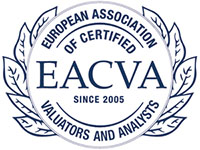Valuation methods

Different business valuation methods are based on:
Cash flows (cash flow based)
- Discounted Cash Flow
- Adjusted Present Value
- Cash to Equity
- Real Options
With cash flow based methods you look at prospective earnings based on all future cash flows. These methods are based on expected cash flows, the risk profile of the company and the so-called time value of money (“money you receive in the future is worth less than the money you have now”).
Free cash flows differ from accounting results. When applying cash flow based methods, the influence of accounting principles that have no effect on cash flows is eliminated. Accounting rules can affect profit, but not cash flows. And unlike other valuation methods, the influence on free cash flows from investments and changes in working capital (stock, accounts receivable and payable, etc.) are taken into account.
Calculations based on cash flows are fairly complex and require know-how, but scientifically speaking they are the most correct.

Ad Scheepbouwer, former CEO of KPN:
Do not assess the value of a company on its profitability, but look at what is in your bank accounts at the beginning and the end of the year. That is the amount that is actually earned in a year.
Capitalized earnings (profit based)
The capitalized earning method is based on the normalized profit, being the result in which the influence of exceptional and incidental results has been eliminated. This profit divided by the required rate of return shows the outcome of this method. Profit, however, is not equal to the available cash flow. Profit depends on the applied valuation and accounting rules and can therefore be manipulated. The difference between the net profit and the free cash flows can be large.
Profit is an opinion... Cash is a fact!
Assets (asset-based)
- net asset value
- liquidation value
The outcome of this method is the difference between the individual (accounting) values of the assets and the liabilities. This is a snapshot. This method does not take into account the profitability of the company and future expectations.
Invoices are paid with cash, not with profit!

Multiples (market-multiples of comparables)
- price/earnings ratios of publicly traded companies
- recent transactions of similar companies
- other performance indicators, such as revenue, gross margin, EBITDA, number of subscriptions, m2 of office space, etc.
The outcomes of these methods can be a benchmark. However, it is not known whether the comparison made is normative. The results are based on realised prices. However, it is unknown how and under which circumstances these prices were established. Furthermore, the question is whether the companies concerned are really comparable. Usually they are not!
Your company is not average and... there is no such thing as an average company!
Comparison of valuation methods
Methode
Calculation
Advantage
Disadvantage
Method
Cash flows:
- Discounted Cash Flow
- Adjusted Present Value
- Cash to equity
- Real options
Calculation
Present value of future cash flows
Advantage
Theoretically the most correct.
Takes into account:
- forecasted cash flows
- risk profile
- time value of money
Disadvantage
- Calculation is complex
- requires substantiated projections
Methode
Capitalised earnings
Calculation
Normalised profit divided by required rate of return
Advantage
Relatively simple
Disadvantage
- Profit is an opinion (and manipulable)
- Is based on history
Methode
Assets / net-asset value
Calculation
Valuation of assets and debts at current or accounting value
Advantage
Relatively simple
Disadvantage
- Is a snapshot
- Does not say anything about profitability
- Is based on history
Methode
Multiples and comparables
Calculation
Multiplying factor with:
- Average profit
- EBITDA
- Revenue, etc.
Advantage
Relatively simple
Disadvantage
- Does not take the specific characteristics of the company into account
- Is based on history
- Is based on prices without knowing how and under which circumstances these were established









